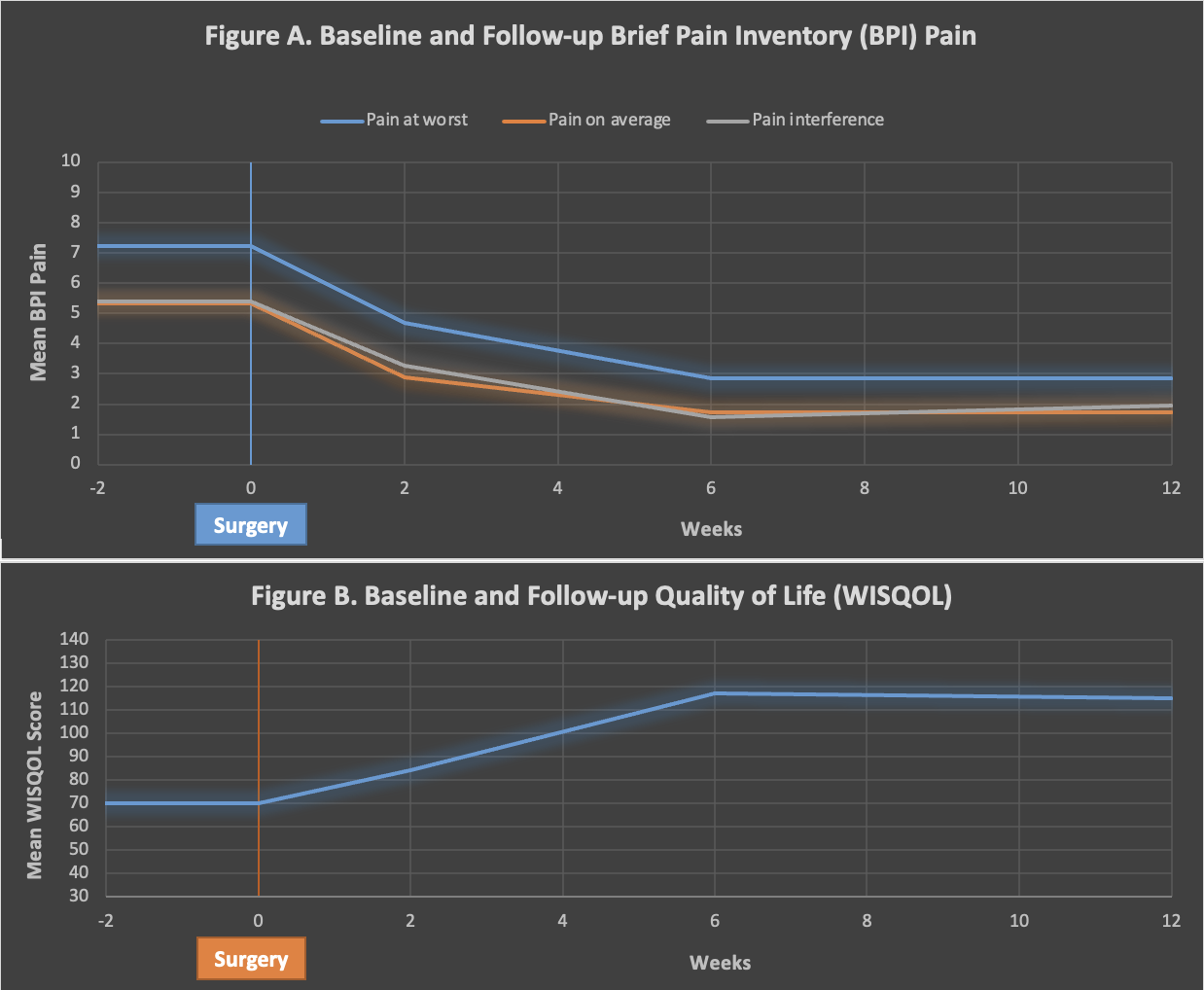Back
Introduction: Pain associated with renal stone disease is typically caused by an obstructive stone resulting in renal collecting system dilatation. However, a number of retrospective studies have examined pain associated with non-obstructing kidney stones and have suggested that their removal is associated with improvement in symptoms. We performed a multicenter prospective study to determine if the removal of small non-obstructing renal calculi can reduce a patient’s pain and/or improve their quality of life.
Methods: We identified patients with small non-obstructing kidney stones (=10 mm maximum length; measured via CT) with associated moderate to severe flank pain (=5 on pain scale). Exclusion criteria included ipsilateral hydronephrosis and nephrocalcinosis. Once all other causes of the pain were clinically ruled out, these patients underwent ureteroscopy (URS) and kidney stone treatment (08/2018-08/2022). Brief Pain Inventory (BPI) and the Wisconsin Stone Quality of Life questionnaire (WISQOL) were completed pre-operatively, and post-operatively at 2, 6, and 12 weeks. A clinically significant decrease in BPI score is 20% was considered the primary study endpoint. All patients underwent 6-8 weeks post-operative imaging to determine stone free status.
Results: A total of 42 patients with small non-obstructing kidney stones with associated flank pain were recruited at 10 sites across North America. From BPI scores, mean pain and worst pain was 5.5 and 7.2 respectively preoperatively; 2.9 and 4.7 respectively at 2 weeks postoperatively; 1.8 and 2.8 respectively at 6 weeks; and 1.8 and 2.8 respectively at 12 weeks post op (Figure A). WISQOL mean score increased from 70.4 preoperatively to 115.3 at 12 weeks postoperatively (Figure B). A total of 86% and 69% of patients had at least a 20% and 50% reduction in their average pain scores at 12 weeks postoperatively, respectively. A total of 75% and 61% of patients had at least a 20% and 50% reduction in their worst pain scores at 12 weeks postoperatively, respectively.
Conclusions: In selected patients with non-obstructing calyceal stones and associated flank pain, stone removal decreases pain and improves kidney stone health-related quality of life. SOURCE OF
Funding: None.

Podium Session
Session: PD28: Stone Disease: Surgical Therapy (including ESWL) III
PD28-02: Treatment of Non-Obstructing Kidney Stones in Patients for Flank Pain: Prospective Multicenter Trial: A CoRE Initiative
Sunday, April 30, 2023
9:40 AM – 9:50 AM CST
Location: S401C

Naeem Bhojani, MD, FRCSC
Associate Professor
University of Montreal
Podium Presenter(s)
Introduction: Pain associated with renal stone disease is typically caused by an obstructive stone resulting in renal collecting system dilatation. However, a number of retrospective studies have examined pain associated with non-obstructing kidney stones and have suggested that their removal is associated with improvement in symptoms. We performed a multicenter prospective study to determine if the removal of small non-obstructing renal calculi can reduce a patient’s pain and/or improve their quality of life.
Methods: We identified patients with small non-obstructing kidney stones (=10 mm maximum length; measured via CT) with associated moderate to severe flank pain (=5 on pain scale). Exclusion criteria included ipsilateral hydronephrosis and nephrocalcinosis. Once all other causes of the pain were clinically ruled out, these patients underwent ureteroscopy (URS) and kidney stone treatment (08/2018-08/2022). Brief Pain Inventory (BPI) and the Wisconsin Stone Quality of Life questionnaire (WISQOL) were completed pre-operatively, and post-operatively at 2, 6, and 12 weeks. A clinically significant decrease in BPI score is 20% was considered the primary study endpoint. All patients underwent 6-8 weeks post-operative imaging to determine stone free status.
Results: A total of 42 patients with small non-obstructing kidney stones with associated flank pain were recruited at 10 sites across North America. From BPI scores, mean pain and worst pain was 5.5 and 7.2 respectively preoperatively; 2.9 and 4.7 respectively at 2 weeks postoperatively; 1.8 and 2.8 respectively at 6 weeks; and 1.8 and 2.8 respectively at 12 weeks post op (Figure A). WISQOL mean score increased from 70.4 preoperatively to 115.3 at 12 weeks postoperatively (Figure B). A total of 86% and 69% of patients had at least a 20% and 50% reduction in their average pain scores at 12 weeks postoperatively, respectively. A total of 75% and 61% of patients had at least a 20% and 50% reduction in their worst pain scores at 12 weeks postoperatively, respectively.
Conclusions: In selected patients with non-obstructing calyceal stones and associated flank pain, stone removal decreases pain and improves kidney stone health-related quality of life. SOURCE OF
Funding: None.

